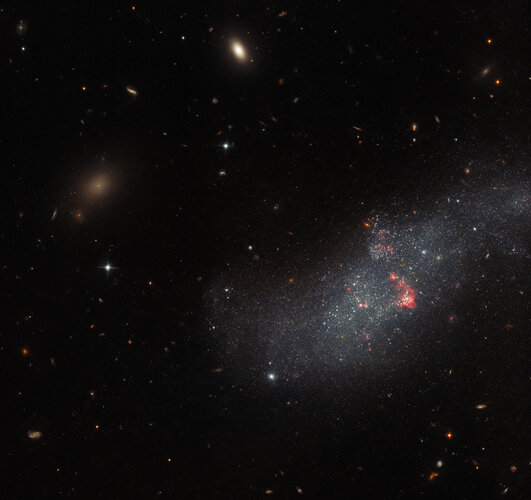UGCA 307 hangs against an irregular backdrop of distant galaxies in this image from the NASA/ESA Hubble Space Telescope. The small galaxy consists of a diffuse band of stars containing red bubbles of gas that mark regions of recent star formation, and lies roughly 26 million light-years from Earth in the constellation Corvus. Appearing as just a small patch of stars, UGCA 307 is a diminutive dwarf galaxy without a defined structure — resembling nothing more than a hazy patch of passing cloud.
This image is part of a Hubble project to explore every known nearby galaxy, giving astronomers insights into our galactic neighbourhood. Before this set of observations, almost three quarters of nearby galaxies had been investigated by Hubble in enough detail to spot the brightest stars and build up an understanding of the stars populating each galaxy. This Hubble project set out to explore the remaining quarter of nearby galaxies by taking advantage of short gaps in Hubble’s observing schedule.
This crystal-clear image was captured by Hubble’s Advanced Camera for Surveys (ACS), which was installed on the telescope in 2002 during Servicing Mission 3B. Hubble’s vantage point in low Earth orbit means that it is above atmospheric turbulence, giving it a sharper view of the Universe. However, it is also close enough to Earth that astronauts could visit the telescope to repair and refurbish the telescope. In total, five Space Shuttle missions flew to Hubble and kept it at the forefront of astronomy by installing new instruments. The ACS replaced one of Hubble’s original instruments, the Faint Object Camera, which was built by ESA.
[Image description: A wide band of bluish light extends from the centre of the image to the right side. It is speckled with many tiny stars, and a few small, bright red bubbles of gas, identifying it as a galaxy. The background is black, and has small galaxies and stars spread around. Most are too small to distinguish, except for two oval-shaped galaxies, each having a hazy glow around a bright centre.]



 Image:
Hubble’s neighbourhood watch
Image:
Hubble’s neighbourhood watch